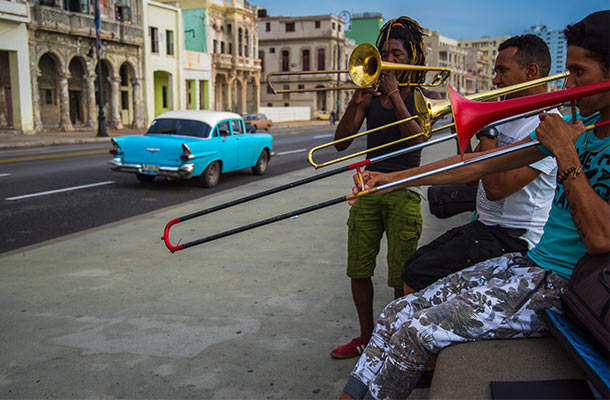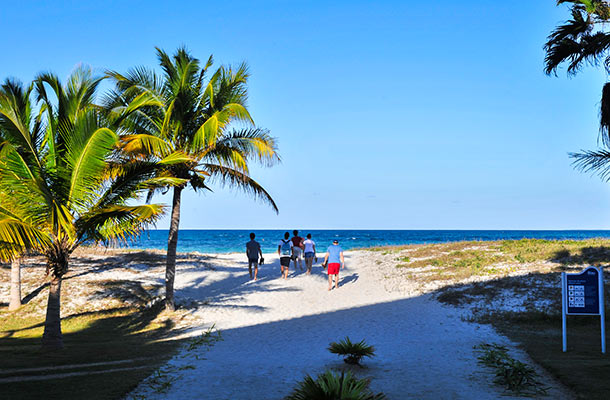From the UNESCO-protected colonial enclave of Habana Vieja to the A-list museums and revolutionary landmarks of gritty Centro, see the best of Havana with our local insider Caroline’s top picks.
 Photo © iStock/merc67
Photo © iStock/merc67
- Habana Vieja
- Centro
- Museo de la Revolución
- Museo de Bellas Artes
- Castillo de la Real Fuerza and Castillo del Moro
Habana Vieja
First-time visitors tend to dedicate the lion’s share of their time to Old Havana, the city’s intensely cinematic, colonial core. And rightly so: with labyrinthine streets lined with crumbling mansions, old men playing dominos in the shade of palms, children playing football beside walls emblazoned with revolutionary iconography – it fulfills every traveler’s image of Cuba.
Day and night, the sound of salsa and rumba fills the air along the main drag of Calle Obispo. Watch some of Cuba’s famed artists at work in their studios, or join the Hemingway Trail at Hotel Ambos Mundos, where Big Ern lived from 1932-1939 – it was here in room 501 that he penned chapters For Whom the Bell Tolls.
Follow in his footsteps with a customary mojito at La Bodiguita del Medio and a daiquiri at La Floridita – it’s every traveler’s rite of passage.
Centro
While it may resemble a war zone in parts, Centro still clings (albeit tentatively) to its Belle Époque.
The neighborhood’s bustling epicenter is Parque Central, the city’s transport and entertainment hub. It’s surrounded by majestic architecture, including the iconic Hotel Ingleterra and the stunning Baroque Gran Teatro de Habana, home to the prestigious Cuban National Ballet.
Running west, along the leafy boulevard of El Prado, the lavish Capitolio is built in the style of Washington’s capital building by dictator Machado in 1926 – a sign of loyalty to his US paymasters.
Just west of the Capitolio, the Partágas Cigar Factory destroys the myth that cigars are rolled on the thighs of dusky virgins. During the 30min tour, visitors gain insight into the entire production process and watch skilled torcedores roll cigars (around 100 per day) as they listen to daily news readings – a tradition since 1895.
El Prado funnels south to Havana’s front yard, the Malecón, a wild and invigorating seafront promenade where lovers swoon, fishermen cast their lines, and teens dive from the rocks.
Museo de la Revolución
One of Havana’s must-see attractions, Havana’s Revolutionary Museum, is housed in the former Presidential Palace and was completed in 1920.
No expense was spared on the lavish structure: The building is topped with a monumental dome and the interiors features dazzling designs by Tiffany & Co.
The staircase is riddled with holes from an unsuccessful attempt by a radical student group to take out President Fulgencio Batista in 1957.
With lashings of revolutionary iconography – and no attempt to even feign objectivity – the museum spotlights the seminal events preceding the Cuban Revolution, as well as the key battles and political aftermath.
Highlights include an evocative exhibit which charts Che and Fidel’s final onslaught against Batista’s troops in 1959, an SAU-100 tank used by Castro during the 1961 Bay of Pigs, and a replica of the yacht Granma from which Castro disembarked with his 80 plus comrades in 1956 to launch the revolution.
Museo de Bellas Artes
Havana’s Fine Art Museum is the city’s cultural highlight. It’s home to an exquisite collection of fine art, ancient Egyptian sarcophagus, colonial masterworks, and contemporary Cuban paintings and sculpture.
Housed in the original 1954 Trocadero Museum, the colonial Cuban wing displays works by Guillermo Collazo (1850-1896), Cuba’s first internationally-recognized artist, fêted for his technical mastery; two of his most distinctive works, La Siesta, 1886 (The Nap) and Dama Sentada a Orillas del Mar, 1891 (Lady Seated by the Seashore) are given pride of place.
Cuba’s most famous painter, Wilfredo Lamb, is aptly represented with a cache of his masterworks that clearly show the influence of Picasso.
The International collection exhibits art from 500BC to the present day with an exceptional collection of works by Gainsborough, Tintoretto, Degas, Zurburĭán, Murillo, and Spanish artists Sorolla and Zubarán; many works belonged to some of Cuba’s richest families, including the Bacardí family, as well as members of Batista’s government, and were left behind after the revolution.
There’s also a collection of Greek, Roman, Egyptian, Etruscan artifacts and sculptures, including a centerpiece Greek Amphora which dates back to the 5th century BC.
Castillo de la Real Fuerza and Castillo del Moro
Havana’s colossal forts stand as testimony not only to Spain’s engineering prowess, but to the city’s strategic importance as a lucrative colonial port.
The second oldest fort, the Castillo de la Real Fuerza, was built in 1558 to defend against pirates, including one French Huganaut Jacques de Soros – known as the ‘Great Exterminator’ – who razed the city in 1555.
Despite its girthsome walls, the fort was hardly impregnable and fell to frequent attacks by English buccaneers and pirates during the early 17th century.
Located on a headland, the Castllo del Moro (also known as El Castillo de los Tres Reyes) was built between 1589 and 1630 and provides the most memorable sunset views of Havana. Today, it’s a museum, displaying a series of exhibits on Cuban history since the arrival of Columbus.
Heading to Cuba? Download our FREE Insider’s Guide!
Related articles
Simple and flexible travel insurance
You can buy at home or while traveling, and claim online from anywhere in the world. With 150+ adventure activities covered and 24/7 emergency assistance.
Get a quote
No Comments